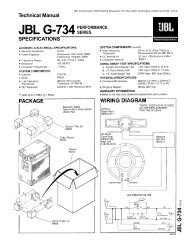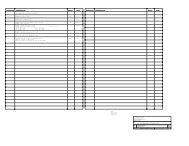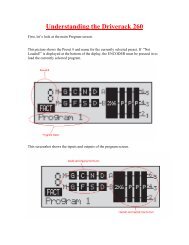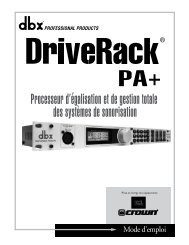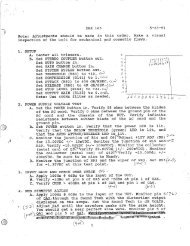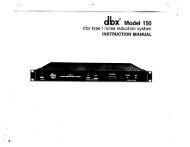Create successful ePaper yourself
Turn your PDF publications into a flip-book with our unique Google optimized e-Paper software.
1.0 Introduction<br />
The introduction will be short because we know that you want to<br />
get this subwoofer up and running as soon as possible. But,<br />
there are some important things you need to know before undertaking<br />
the unpacking and connecting process. This subwoofer<br />
has features that you need to be familiar with prior to installation<br />
to get the best perfor<strong>man</strong>ce.<br />
2.0 Unpacking your Subwoofer<br />
After opening the box, check the unit for shipping damage before<br />
connecting to the AC supply and note if any damage relates to<br />
any holes or crushing of the outer carton. There are no rattles or<br />
loose pieces inside the subwoofer system by design, so if you<br />
hear anything that sounds inappropriate for a powered subwoofer<br />
while unpacking it, stop now, and check the carton for signs of<br />
damage. If damage has occurred, contact your freight carrier<br />
right away and have them register your damage claim.<br />
3.0 Placement of the Subwoofer<br />
The subwoofer is a compact device, which allows the unit to be<br />
easily placed where it can provide optimum perfor<strong>man</strong>ce. As part<br />
of the placement process, the perfor<strong>man</strong>ce can be fine-tuned by<br />
adjusting the user controls provided. You only have to do this the<br />
first time you set your system up. Once the balance is set<br />
between the subwoofer and the main speakers, the installation is<br />
complete. The general rule for placement is between the left and<br />
right channels in a two channel system or under the center channel<br />
in a 5.1 or other surround system. If two subwoofers are<br />
used, they are ideally positioned under, or close to the front left<br />
Example<br />
3 Room Boundary<br />
(2 Walls and 1 Floor = +6 dB)<br />
and front right main<br />
speakers.<br />
The governing factor in<br />
bass response heard at a<br />
given location in any<br />
room, are room modes. In<br />
addition, it is important to<br />
remember that a corner<br />
position offers the best<br />
chance of exciting the most room modes (diagonal, orthogonal,<br />
and axial), but this also changes the loading on the subwoofer<br />
which increases the amount of bass output. Placing the subwoofer<br />
in a corner (two walls and a floor) gives another 3 dB<br />
more low frequency energy over the two-boundary location, for a<br />
total of 6 dB over the unit in the middle of the floor. When you’re<br />
setting things up the first time, adjust the subwoofer level for the<br />
various room positions you try, keeping the overall system balance<br />
the same. The point of playing with the subwoofers room<br />
placement is to get a smooth and even bass response, rather<br />
than just getting lots of low frequency sound.<br />
If you’re using Tannoy main speakers, you may want to consider<br />
experimenting, using the closed cell reflex port foam plugs that<br />
were originally included in the speaker packaging. This will help<br />
tighten up the mid bass (80 Hz+) perfor<strong>man</strong>ce, since we don’t<br />
need the ports to enhance the bass below 80 Hz. This plug is a<br />
pressure fit, so it can be removed at a later date if required. Here<br />
are some additional tips that will help you get the best during setup:<br />
Experiment with the subwoofer features<br />
Make sure you’re not being impressed with more bass instead<br />
of smooth bass<br />
Don’t rely on a one third Octave RTA (Real Time Analyzer) to<br />
look for accurate guidance on level adjustment, or for room mode<br />
response at any specific position. It doesn’t have the time or frequency<br />
capability. The best way to listen is with a progression of<br />
low frequency notes. Are there drastic variations in the level of<br />
those notes? If they come out of the signal source at the same<br />
level, you can be sure that any problems are room related. If one<br />
listening position seems to provide significant variations, try<br />
another position several feet away. Because the wavelength of<br />
bass frequencies is quite long, it usually takes a change of position<br />
equal to a good fraction of the wavelength to hear the difference.<br />
You also want to strive for a large listening area. It doesn’t help<br />
to have a point in your listening space be perfect, but have that<br />
point be so small that you can’t get both ears into it at the same<br />
time. Every listening situation will be different, and we can’t offer<br />
more specific guidance on positioning than experiment and listen<br />
to material you trust.<br />
A subwoofer is an excellent tool for finding <strong>new</strong> sources of rattles<br />
and buzzes in the listening area. Because there is a concentrated<br />
low frequency source involved, nearby objects, such as wall panels,<br />
equipment cover plates, and other objects may become excited and<br />
pollute your systems perfor<strong>man</strong>ce. You need to track down each rattle<br />
and buzz and correct it at the source of the problem.<br />
4.0 Installation<br />
Sit the subwoofer in, or close to, where you believe its final position<br />
will be. Make sure you have easy access to the amplifier<br />
panel and controls. Plug the subwoofer into a wall outlet, preferably<br />
the same outlet, or at least the same circuit as your main<br />
speaker amplifier. Connect the signal source outputs to the input<br />
connectors of your subwoofer. Here is where you have two choices:<br />
Note: For the <strong>PS110</strong> version the following options also apply to<br />
using the speaker level wiring option. However, speaker level<br />
needs to be fed to the subwoofer from a two channel amplifier,<br />
not a line level signal from a signal source. The speaker wires on<br />
the subwoofer output side will go directly to the main speakers’<br />
inputs, not the main speakers’ amplifier (fig. 1).<br />
- +<br />
Right Speaker Out<br />
AMPLIFIER<br />
-<br />
Left Speaker Out<br />
Figure 1<br />
Speaker level setup using<br />
internal high pass filter.<br />
+<br />
IN OUT<br />
LEFT RIGHT<br />
+<br />
Speaker Level IN<br />
-<br />
-<br />
High Pass OUT<br />
+<br />
<strong>PS110</strong><br />
a: (Recommended) Another set of cables can be used to connect<br />
the subwoofer outputs to the L and R inputs of the main speaker<br />
amplifier. Please, don’t use cheap cables to connect the subwoofer.<br />
Buy quality components for your audio installation. It will<br />
pay off in the final experience. Using this connection method<br />
allows use of the subwoofers built-in high pass filter network to<br />
provide smooth transition of frequencies between the subwoofer<br />
and the main speaker system (<strong>PS110</strong> fig. 2, <strong>PS110</strong>B fig. 3).<br />
LEFT<br />
RIGHT<br />
Right<br />
Speaker<br />
-<br />
Right<br />
Speaker<br />
+<br />
Left<br />
Speaker<br />
+<br />
Left<br />
Speaker<br />
-




